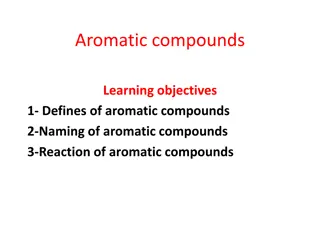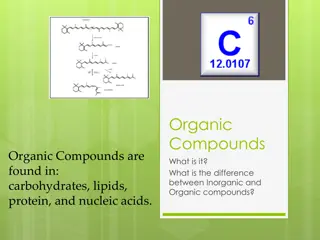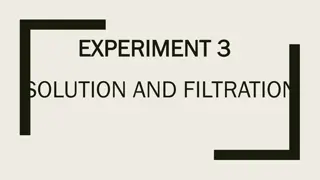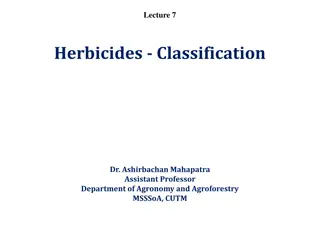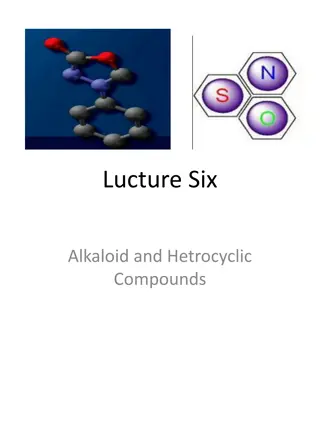The Role of Inorganic Nitrate in Preventing Contrast-Induced Nephropathy
Contrast-Induced Nephropathy (CIN) poses risks to patients undergoing angiography. This study evaluates the potential benefits of dietary inorganic nitrate in preventing CIN and its mechanisms. Results show promising renoprotective effects, highlighting a potential preventive approach for at-risk pa
1 views • 25 slides
Organometallic Chemistry (CHEM 42 1)
Organometallic chemistry delves into compounds with carbon-metal bonds, merging concepts from inorganic and organic chemistry. The field encompasses diverse compounds like ferrocene and tris(triphenylphosphine)rhodium carbonyl hydride, with nomenclature based on naming organic groups and adding meta
1 views • 13 slides
Aromatic compounds
Aromatic compounds are chemical compounds containing a ring with delocalized pi electrons. Learn about the definition, naming conventions, and reactions of aromatic compounds such as benzene. Explore topics like aryl groups, halogenation reactions, and the mechanism for bromination of benzene.
0 views • 19 slides
Introduction to Co-ordination Chemistry: Fundamentals and Applications
Explore the fascinating field of coordination chemistry, delving into the complexity of compounds and the coordination bonds that govern their structures. Discover the history, key concepts, and applications of coordination chemistry through a detailed examination of coordination compounds, bonding
13 views • 73 slides
Understanding Physiological Acid-Base Balance in Pharmaceutical Inorganic Chemistry
This lecture delves into the fundamental concepts of pharmaceutical inorganic chemistry, focusing on the mechanisms and uses of various pharmaceutical products that correct body disorders. Topics covered include acids and bases, intra and extracellular electrolytes, and the role of buffers in mainta
10 views • 14 slides
Organometallic Compounds of Group 2 Elements
In the realm of organometallic chemistry, Group 2 elements, specifically alkaline earth metals like beryllium and magnesium, exhibit intriguing properties and reactivities. The chemistry of these elements, mimicking that of Group 12 elements in many aspects, leads to the formation of various organom
5 views • 27 slides
Overview of Herbicides Classification and Groups
Herbicides are classified based on their chemical nature into inorganic and organic types. Inorganic herbicides, such as arsenic acid and copper sulfate, do not contain carbon atoms, while organic herbicides, like glyphosate and 2,4-D, contain carbon atoms. The classification includes various groups
4 views • 15 slides
Understanding Minerals: A Comprehensive Guide
Earth's crust is composed of rocks made up of different minerals, which are naturally occurring, inorganic solids with distinct atomic structures and chemical compositions. Minerals exhibit properties like solidity, natural occurrence, inorganic nature, fixed composition, and crystal form. Identifyi
2 views • 20 slides
Understanding Organic Compounds and Their Importance in Daily Life
Explore the world of organic compounds, including their definition, difference from inorganic compounds, common elements found in them, and the significance of hydrocarbons. Learn about the essential role of organic compounds in living organisms, such as proteins, carbohydrates, and fats, and how th
1 views • 51 slides
Understanding Biosynthetic Pathways in Living Organisms
Biosynthesis, also known as anabolism, involves the formation of complex organic compounds from simple subunits catalyzed by enzymes within living organisms. This process is vital for the development of life and the production of essential compounds like carbohydrates, proteins, vitamins, antibiotic
1 views • 21 slides
Impact of Land-Use Consolidation Program on Farm Inputs in Rwanda
The study evaluates the effects of Rwanda's land-use consolidation program on farm input uptakes, specifically focusing on hybrid seeds, inorganic fertilizers, and pesticides. Results show significant increases in the adoption of hybrid seeds and inorganic fertilizers among participating households
0 views • 10 slides
Mastering Compound Naming for Chemistry Students
Develop your ability to name compounds and write their chemical formulas with ease by understanding the naming conventions for different compound types. Learn about compounds composed of metal and non-metal elements, compounds containing oxygen, and those made only of non-metals. Practice naming spe
2 views • 14 slides
Overview of Anticestodal Drugs in Veterinary Pharmacology
Anticestodal drugs play a crucial role in combating tapeworm infections in veterinary medicine. These drugs are classified into taeniafuges and taenicides, with examples of natural and synthetic compounds highlighted. Natural compounds like pumpkin seeds and male fern are traditionally used for thei
0 views • 29 slides
Separation and Purification of Organic Compounds: Methods and Techniques
The separation and purification of organic compounds are essential processes to obtain pure products, as impurities and side reactions can affect the quality of the compounds. Methods such as solution and filtration, crystallization, distillation, extraction, sublimation, and chromatography are comm
8 views • 15 slides
Innovative Use of Sea Water in Drilling Fluid Development
This work focuses on leveraging sea water as an alternative to inorganic salts in drilling fluid formulations, reducing logistical costs and enhancing offshore operations. The development process involved scaling down additives to nano-size, aiming to create a product that not only replaces Lime in
1 views • 10 slides
Inorganic Pharmaceutical Chemistry: Applications and Importance
Inorganic pharmaceutical chemistry explores the study of elements and compounds excluding carbon, with diverse applications in pharmacy. It encompasses the synthesis and use of inorganic compounds in drug development, catalysis, pigments, and agriculture. The field also delves into the medicinal val
1 views • 6 slides
Understanding Fertilizers and Their Types
Fertilizers are essential for plant growth, providing nutrients necessary for healthy development. They are classified into organic and inorganic types, each with its own advantages and disadvantages. Organic fertilizers, sourced from natural materials like plants and animals, enrich the soil with o
2 views • 7 slides
Solubility Rules from the University of South Carolina
This resource outlines the solubility rules for various compounds based on their chemical properties. It explains the solubility of compounds of alkali metals, ammonium salts, nitrates, chlorides, sulfates, and more. The rules provide insights into which compounds are soluble or insoluble in aqueous
1 views • 10 slides
Understanding the Role of Starter Culture in Fermented Milk Products
Starter cultures play a crucial role in the production of fermented milk products by producing antimicrobial compounds like organic acids, H2O2, CO2, aroma compounds, fatty acids, and bacteriocins. These compounds help prevent spoilage by inhibiting the growth of harmful bacteria and altering cellul
6 views • 9 slides
Overview of Herbicides Classification and Chemical Nature
Herbicides are classified based on their chemical nature into inorganic and organic herbicides. Inorganic herbicides do not contain carbon atoms, while organic herbicides contain carbon atoms. They are further categorized into 31 classes, each with distinct properties and modes of action. This class
0 views • 15 slides
Understanding Angular Overlap Method in Advanced Inorganic Chemistry
Exploring the Angular Overlap Method (AOM) in advanced inorganic chemistry provides a qualitative discussion on the physical rationale behind the theory of complexes. By considering the interaction of atomic orbitals and the degree of overlap, AOM offers insights into energy quantification in coordi
0 views • 15 slides
Understanding Rodenticides: Types, Effects, and Treatment
Rodenticides are chemical preparations used for rodent control, primarily targeting mice and rats. They play a crucial role in managing rodent populations to prevent associated losses. The chapter covers an introduction to rodenticides, their classification into organic and inorganic types, mechanis
0 views • 19 slides
Alkaloids and Heterocyclic Compounds: A Comprehensive Overview
Alkaloids are natural compounds containing nitrogen, with various pharmacological activities. Heterocyclic compounds, essential to life, include a diverse range of compounds such as alkaloids, antibiotics, and vitamins. The lecture delves into the properties, classifications, and examples of these c
12 views • 7 slides
Exploring Bioinorganic Chemistry: Connecting Inorganic and Biochemistry
Bioinorganic Chemistry bridges the gap between inorganic chemistry and biochemistry, understanding the vital role of inorganic elements in living systems. This interdisciplinary field delves into the structure, function, and exploitation of metal ions in biological processes, emphasizing their inter
0 views • 47 slides
Overview of Wastewater Treatment Units and Processes
Screening units with screens and racks remove coarse solids, comminutors reduce the size of suspended solids, and grit chambers remove sand and metal fragments from wastewater to protect downstream equipment and processes. The floatation tank removes grease, while different designs of grit chambers
5 views • 15 slides
Coordination Numbers in Inorganic Compounds: Geometries and Structures
In inorganic coordination complexes, the coordination number refers to the number of atoms bonded to the central atom. Common geometries include octahedral, tetrahedral, and square planar, depending on the type and number of ligands. Transition metal complexes exhibit different coordination numbers
2 views • 8 slides
Isomerism in Inorganic Complexes: A Comprehensive Overview
Isomerism in inorganic complexes is a fascinating phenomenon arising from the specific spatial arrangements of atoms within molecules. This article delves into the types of isomerism found in coordination compounds, such as structural isomerism and stereoisomerism. The importance of studying isomers
0 views • 67 slides
Understanding Cell Processes and Energy
Explore the fundamentals of cell processes and energy, including the concepts of elements, compounds, organic and inorganic compounds, carbohydrates, lipids, proteins, and enzymes. Learn about the essential role of water and the significance of different types of compounds in living organisms.
0 views • 60 slides
Impact of Replacing Inorganic Zinc with Organic Zinc on Buffalo Calves
The study explores the effects of replacing inorganic zinc with a lower level of organic zinc (zinc propionate) on performance, biochemical constituents, and mineral status in buffalo calves. Zinc deficiency is a critical issue affecting growth, immunity, and reproduction in livestock. Inorganic min
0 views • 27 slides
Integrated Terrestrial-Coastal Ocean Framework for Carbon Management
An advanced framework integrating terrestrial and coastal ocean observations and modeling is developed to support carbon management decisions. The study focuses on assessing the impacts of land use, human activities, and climate scenarios on the carbon cycle, particularly dissolved inorganic carbon
0 views • 5 slides
Methods of Business Expansion and Key Terms Explained
Methods of business expansion can be organic or inorganic, with inorganic methods including strategic alliances, mergers, and takeovers. Key terms such as inorganic growth, joint ventures, acquisitions, and subsidiaries are crucial for understanding business expansion strategies.
0 views • 23 slides
Understanding Organic Chemistry and Macromolecules
Organic chemistry focuses on compounds with carbon bonds, while inorganic chemistry deals with other compounds. Carbon is unique due to its ability to form multiple bonds, creating diverse structures like chains and rings. Organic compounds, produced by living organisms, range from simple to complex
0 views • 32 slides
Exploration of Fossils and Compounds in Science Learning
Archaeologists search for fossils in specific types of rocks, while students learn about compounds and their formation through engaging activities. Compounds are combinations of two or more elements, each with distinct naming conventions. Students practice naming compounds based on their constituent
0 views • 10 slides
The Role of Nitrogen in Plant Biochemistry: Understanding Nitrogen Metabolism
Nitrogen is a crucial element in plant biochemistry, essential for protein synthesis and the formation of various organic compounds. This article explores the sources of nitrogen available to plants, including atmospheric nitrogen, nitrates, and organic nitrogen compounds. The importance of nitrogen
0 views • 15 slides
Understanding Ionic and Molecular Compounds in Chemistry
Discover the fundamental concepts of ionic and molecular compounds in chemistry with insights into the nature of elements, formation of compounds, and properties of ions. Explore the differences between ionic and covalent bonds, positive and negative ions, as well as examples of common everyday comp
0 views • 54 slides
Overview of Important Glycoside Compounds and Their Properties
Glycoside compounds play a significant role in various biological processes, with groups like steroids and cardenolides showcasing notable medicinal effects. Steroids are crystalline substances with specific solubility characteristics, while cardenolide glycosides are known for their toxic effects o
0 views • 13 slides
Understanding Heterotrophic Nutrition in Organisms
Heterotrophic nutrition refers to the process where organisms, such as animals, rely on preformed organic molecules from their environment or other organisms for nutrients and energy. These organisms are unable to produce organic compounds from inorganic sources and must obtain nourishment from exte
0 views • 55 slides
Analysis of Inorganic Fertilizer Supply Chain in Uganda
Examining the accessibility and quality of inorganic fertilizers in Uganda, the study focuses on key regions, targeted fertilizers, methodology, findings on moisture content and weight compliance, and implications for farmers. The research sheds light on challenges and opportunities in the country's
0 views • 17 slides
Essential Nutrients for Plant Tissue Cultures: A Comprehensive Guide
The composition of culture media for plant tissue cultures includes inorganic and organic nutrients, sources of energy like sucrose and amino acids, and essential macro and micronutrients. Providing gas exchange, waste removal, and growth regulators, the medium supports plant growth by offering acce
0 views • 22 slides
Insights into the Vanadium Industry and Chemical Compounds
Michael R. Woolery, a Chemical Engineer with extensive experience in vanadium processes, sheds light on the U.S. vanadium industry, sodium orthovanadate compound, toxicokinetic properties of organic vs. inorganic vanadium compounds, environmental exposure sources, and the impact of reference doses o
0 views • 6 slides


